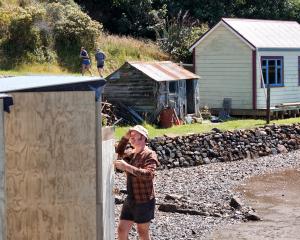New Zealand is a land perfect for growing trees. Kim Dungey talks to author Peter Janssen, who has been documenting the most characterful specimens.
If every tree has a story to tell, the Moreton Bay fig that a neighbour has planted on Peter Janssen's boundary might tell of shaking in its roots.
"Both of us are going to live in tree houses eventually because these trees are massive," Janssen says, over the phone from his home in Auckland. "I like trees, but he's going to have to take it out."
Bigger than Ben Hur is how he describes one Moreton Bay fig that appears in his new book, Trees of New Zealand: stories of beauty and character. Planted about 1850 in Pahi, on the Kaipara Harbour, it has a spread of more than 42m. The one on his own boundary sits between houses that are 10m apart.
While thoughtless planting sometimes causes conflict, New Zealanders generally do like trees, Janssen says, adding that, when he worked for Reed Publishers, tree books outsold any other category of natural history five to one.
One reason for this is that, unlike in Europe with its very big cities, trees are a part of our everyday life.
Another is that New Zealand is a land that is perfect for growing trees - moderate temperatures and good rainfall mean a height of 40m is not uncommon for indigenous trees and some imported trees grow faster here than in their native countries.
Janssen and photographer Mike Hollman covered the length of New Zealand to highlight more than 100 of the country's most remarkable trees.
While some are famous for their size, others were chosen for their history or beauty. All of them can be easily seen by the public.
The author says he deliberately kept the text light:"Rather than being terribly earnest and saying this is how you identify this tree ... it just looks at why these trees capture our imagination and why we are emotionally attached to them."
The 13 entries from Otago include New Zealand's tallest tree, a 70m-high mountain ash (Eucalyptus regnans) at the Orokonui Ecosanctuary that towers 30m higher than the revered kauri Tane Mahuta; a weeping ash (Fraxinus excelsior 'Pendula') in front of Knox Church that he rates one of the most photogenic trees in the country; and the so-called Wooing Tree in Cromwell.
An ordinary-looking pine, the Wooing Tree would never have made it into some other books because it is not a rare species or the biggest or best, he says. But to local people, it is the most important tree in the area.
When the block containing it was sold to New Zealanders living overseas and the new owners gave the go-ahead to clear the land of trees before the planting of grapevines, locals swung into action. Out came stories of romance, marriage proposals and even conceptions "all linked to this one old tree".
"What was nice was that the people who had bought the land bought into the whole emotional connection ... and not only saved the tree but named their vineyard after it."
Janssen says it is easy to be moralistic about Maori burning the vast totara forests in the South Island and Europeans clearing huge areas for timber and farming. But early settlers faced different economic circumstances and simply could not imagine running out of the resource.
Individual trees also had significant cultural value to both Maori and European.
Maori often declared individual trees associated with important events or people tapu (sacred or protected) and even walking under some of them could result in death.
One of these is a pohutukawa at Kawhia to which the waka Tainui tied up when it first made landfall in the harbour. Another sacred tree is a 27m-high matai near Rotorua named after the Maori chieftainess Hinehopu, who hid in the hollow of the tree as a child to evade a warring party of warriors from another iwi and who later met her husband under its branches.
And New Zealanders continue to use trees to commemorate occasions and people - one of the trees in the book is a pohutukawa that was planted in Gisborne by the late Princess Diana when she toured New Zealand in 1983.
Asked for his personal favourites from the book, Janssen nominates a group of Italian cypress (Cupressus sempervirens) surrounding a historic church at Waimea West, that have a spiral shape perfectly mimicking the church's spire, and a 19th-century orchard above the sluicings near Bannockburn - "it's just such a beautiful site and those trees are tough and old".
And in his own garden?
"I have a funny little patch of manuka, and manuka, when it grows to be an older tree, is actually very beautiful."













